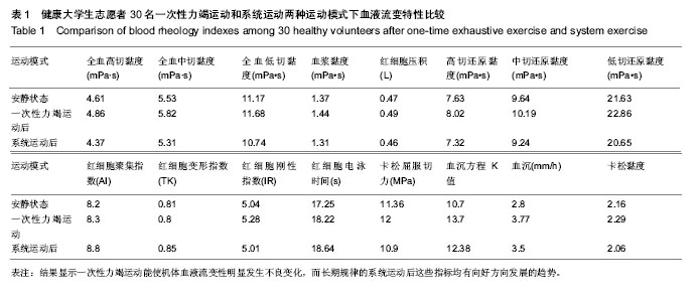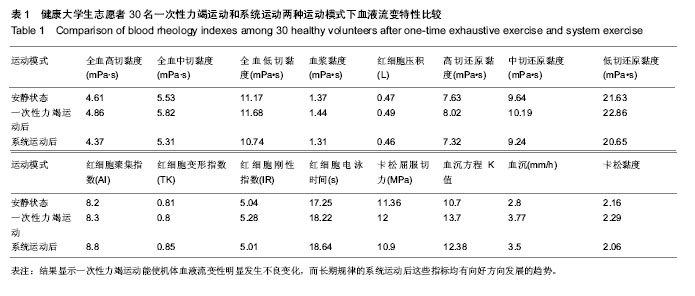| [1] 王海滨,孙海涛.不同运动方式对人体血液流变学的影响分析[J].河南教育学院学报:自然科学版,2008,17(1):88-90.
[2] 陈德权,李伟,李慧,等.运动对血液流变性的影响及相关机制[J].漳州师范学院学报:自然科学版,2010,3:146-149.
[3] 于基国.运动和运动训练对红细胞的影响[J].中国运动医学杂志,1997,16(2):146-147.
[4] 陈英杰.不同强度的规则运动对血小板功能的影响及其机理的探讨[J].连云港职业技术学院学报,2003,16(2):60-62.
[5] 洪平.力竭性大强度耐力训练对优秀竞走运动员红细胞渗透脆性的影响[J].北京体育大学学报,1997,20(4):29-34.
[6] 任建生.长期运动训练对血液流变学的影响[J].中国运动医学杂志,1996,15(4):280-282.
[7] 赵民,杨国蕾,冬云珊,等.运动对于血液流变学某些参数的影响[J].体育科研,1991,2:25.
[8] 陈吉棣,李可基,霍卓平,等.运动员贫血的研究[J].中国运动医学杂志,1990,9(4):193.
[9] Rainhart WH. Impaired red cell filterability with elimination of old red cells during a 100-km race.JAppl Physio. 1983;54(3): 827-830.
[10] 伊藤朗.从运动生化到运动处方[M ].北京:北京体育学院出版社, 1989:123-126.
[11] 黄益民,陈英杰,钟伟,等.运动延迟性损伤系列研究之二大负荷运动后大鼠血液流变学的动态研究[J].中国运动医学杂志, 1996, 15(3): 230-233.
[12] 李可基,陈吉棣,陈志民,等.运动负荷中红细胞流变性的初步研究[J].中国运动医学杂志,1989,8(1):1 -5.
[13] 彭莉,李焕春,肖国强.力竭性运动影响血液流变性的相关因素分析[J].西南师范大学学报,2006,31(3):72-76.
[14] 陈绍芬.急性心肌梗塞的血液流变学变化的临床意义[J].医学综述,1996,2(2):85-86.
[15] Glagov S, Zarins C, Giddens DP, et al. Hemodynamics and atherosclerosis: insights and perspectives gainedfrom studies of human arteries.Arch Pathol Lab Med.1988;112:1018-1031.
[16] Cunningham KS, Gotlieb AI.The role of shear stress in the pathogenesis of atherosclerosis.Lab Invest.2005:85:9-23.
[17] 刘有军,刁越,高松.血液动力学与动脉粥样硬化(一)[J].北京生物医学工程,2004,23:293-295.
[18] Augst AD,Ariff B,McG Thom SA,et al.Analysis of complex flow and the relationship between blood pres-sure wall.Physiol Heart Circ.2007;293(2):H1031-1037.
[19] Li YS, Hags JH, Chien S. Molecular basis of the effects of shear stress on vascular endothelial cells.J Biomech. 2005; 38(10):1949-1971.
[20] 孙涛,王颖,马志勇,等.兔颈总动脉不同形式剪切力及动脉粥样硬化模型的构建[J].2011,49(2):62-66.
[21] 王家权.动脉粥样硬化的流体力学机制的理论研究和数值模拟研究[D].北京:北京工业大学,2002.
[22] 马桂清.血液流变学检验及临床应用分析[J].中国保健营养, 2013, 1:458.
[23] 陶祖莱.生物力学导论[M].天津:天津翻译出版社,2001.
[24] 乔爱科,刘有军.ANSYS和MATLAB在血流动力学可视化中的应用[J].北京工业大学学报,2003,29(1):87-93.
[25] 乔爱科,刘有军,伍时桂.弯曲动脉的血流动力学数值分析[J].计算力学学报,2003,20(2):155-163.
[26] 蔺嫦燕,吴广辉,李冰一,等.Ⅱ型轴流VAD的CAD及流场分析[J].透析与人工器官,2005,16(3):18-23.
[27] 毛江洪,汪青山,钮心怡,等.临床血液流变学的研究现状[J].中国优生与遗传杂志,2013,5:148-151.
[28] 蒋灵霓.血液流变学检验影响因素及临床应用探讨[J].国际检验医学.2012,33(5):633-635.
[29] 林汉锋.血液流变学检验及临床应用[J].中国医药指南, 2011, 9(20):39-40.
[30] 马丽君,梁丽珍.关于一次性运动对运动员血液流变性影响的探讨[J].考试周刊,2009,27(下卷):150-151.
[31] 任建生.一次性运动对血液流变学的影响[J].中国运动医学杂志,1996,3:211-215.
[32] 武宝爱,吴丽君.不同运动形式对人体血液流变性及血小板功能的影响[J].成都体育学院学报,2012,38(4):81-85.
[33] Mitchell A, Collins W. Plasma volume change during heavy-resistance weight lifting.Eur J Physiolatry.1986,55:44.
[34] Coyle EF, Hopper MK, Coggan AR.Maximal oxygen uptake relative to plasma volume extension.Int J Sports Med. 1990; 11(2):116
[35] 李发琪,杨瑞芳,蒋稼欢,等.大鼠运动力竭后肠系膜毛细血管血流动力学变化的研究[J].中国运动医学杂志,1999,18(1):34-35.
[36] 肖明冬.血液流变学在运动医学研究中的应用[J].吉林体育学院学报,2006,22(2):75-78.
[37] 陈伟华,吴纪饶.运动影响血液流变性[J].中国临床康复, 1999, 9(16):187-189.
[38] 薛蕴菁,高培毅,代成波.颈动脉分叉血液动力状态的计算流体力学初步研究[J].中华放射学杂志,2006,40(6):638-642.
[39] 秦海强,王拥军.局部血液动力学与颈动脉粥样硬化性斑块[J].中国卒中杂志,2008,1(3):65-69. |

